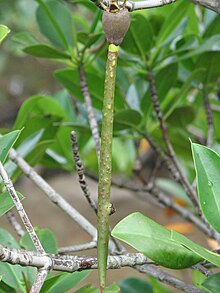Rhizophora mucronata
| Rhizophora mucronata | |
|---|---|

| |
| With propagule | |
| Scientific classification | |
| Kingdom: | Plantae |
| Clade: | Tracheophytes |
| Clade: | Angiosperms |
| Clade: | Eudicots |
| Clade: | Rosids |
| Order: | Malpighiales |
| Family: | Rhizophoraceae |
| Genus: | Rhizophora |
| Species: | R. mucronata
|
| Binomial name | |
| Rhizophora mucronata | |
| Synonyms[2] | |
| |
Rhizophora mucronata (loop-root mangrove, red mangrove or Asiatic mangrove)[3][4] is a species of mangrove found on coasts and river banks in East Africa and the Indo-Pacific region.
Description


Rhizophora mucronata is a small to medium size evergreen tree growing to a height of about 20 to 25 metres (66 to 82 ft) on the banks of rivers. On the fringes of the sea 10 or 15 metres (33 or 49 ft) is a more typical height. The tallest trees are closest to the water and shorter trees are further inland. The tree has a large number of aerial stilt roots buttressing the trunk. The leaves are elliptical and usually about 12 centimetres (4.7 in) long and 6 centimetres (2.4 in) wide. They have elongated tips but these often break off. There are corky warts on the pale undersides of the leaves. The flowers develop in axillary clusters on the twigs. Each has a hard cream-coloured
Distribution and habitat
Rhizophora mucronata is found in the Indo-Pacific region on the banks of rivers and on the edge of the sea. It is the only mangrove species to be found in East Africa.
The natural habitat of Rhizophora mucronata is estuaries, tidal creeks and flat coastal areas subject to daily tidal flooding. It seems to be more tolerant of inundation than other mangrove species and often forms an evergreen fringe to mangrove areas. It sometimes occurs as a pure stand or may grow with Rhizophora apiculata.[6] The red mangrove is a protected tree in South Africa.[7]
Ecology
Rhizophora mucronata regenerates easily from seed but the seedlings are often damaged by crabs.
Uses
Rhizophora mucronata has multiple uses. It is used to help prevent
References
- ^ . Retrieved 19 November 2021.
- ^ Missouri Botanical Gardens. Retrieved 2017-02-05 – via The Plant List. Note that this website has been superseded by World Flora Online
- ^ a b "Rhizophora mucronata". Germplasm Resources Information Network. Agricultural Research Service, United States Department of Agriculture. Retrieved 2012-10-07.
- ^ a b c d Duke, James A. (1983). "Rhizophora mucronata Lam". Handbook of Energy Crops. Retrieved 2012-10-08.
- ^ a b c Gillikin, David; Verheyden, Anouk (2005). "Rhizophora mucronata Lamk. 1804". A field guide to Kenyan mangroves. Retrieved 2012-10-07.
- ^ a b "Rhizophora mucronata". AgroForestryTree Database. World Agroforestry Centre. Retrieved 2012-10-07.
- ^ "Protected Trees" (PDF). Department of Water Affairs and Forestry, Republic of South Africa. 15 June 2013. Archived from the original (PDF) on 5 July 2010.
- ^ Wildlife Holidays India. "Mangalavanam Bird Sanctuary". Retrieved 2012-10-08.
External links
- "Rhizophora mucronata Lam". Atlas of Living Australia.
- "Rhizophora mucronata Poir". Atlas of Living Australia.

